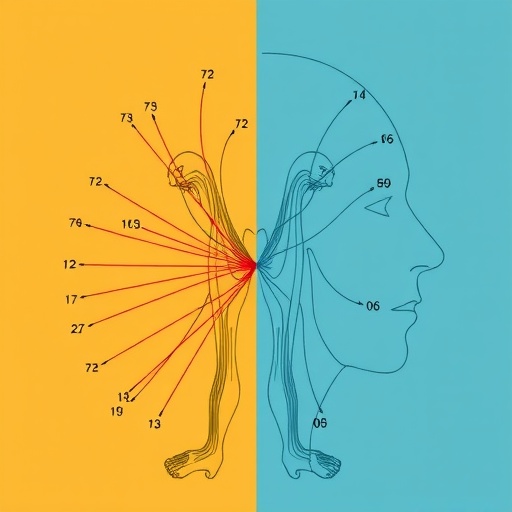In the dynamic field of neuroscience, understanding how the brain prepares for movement has long captivated researchers. Historically, the focus has been on self-initiated actions, where the motor cortex exhibits predictable activity patterns that correspond tightly to the parameters of an intended movement. These preparatory neural signals set the stage for precise execution, encoding details such as movement direction and force before the action commences. However, in everyday life, movements are frequently adjusted or triggered by external sensory stimuli, such as unexpected mechanical perturbations to the body. This raises a vital question: how does the brain prepare for these sensory-driven disruptions, and can such preparation enhance motor responses?
Recent groundbreaking research has provided compelling evidence that the nervous system does not merely react passively to sensory disturbances but actively incorporates expectations about these inputs into its preparatory activities. Conducted by a team led by Michaels, Kashefi, and Zheng and published in Nature, the study delves deep into how probabilistic cues about forthcoming mechanical perturbations influence neural population dynamics in the motor circuits of both humans and non-human primates. By leveraging high-density neural recordings, the researchers uncover that sensory expectations are encoded widely across the brain, notably within motor cortical regions traditionally associated with self-initiated movement preparation.
This study begins by methodically probing how subjects — both human participants and monkeys — respond to mechanical perturbations when provided with probabilistic cues hinting at the likely direction of forthcoming disturbances. These cues enable the subjects to anticipate potential perturbations and adjust their preparatory neural states accordingly. Behavioral analyses reveal that such sensory expectations translate into measurable improvements in the precision and rapidity of corrective motor responses, highlighting the functional advantage of incorporating predictive sensory information into movement planning.
At the neural level, this anticipatory mechanism manifests in the geometry of preparatory signals within the population neural state-space. The researchers demonstrate that the shape and orientation of these signals are surprisingly straightforward, and their magnitude scales linearly with the probability associated with each potential perturbation direction. This elegant scaling suggests a robust neural code where the motor cortex flexibly recalibrates its state depending on sensory expectations, effectively creating a preparatory landscape tuned to the statistical structure of the environment.
Following the onset of perturbations, the motor cortical state undergoes a rapid and condition-independent shift, characterized by a neural signal that propels the system towards generating corrective responses. Intriguingly, these initial responses appear to be heavily influenced by the sensory expectations established during the preparatory phase, indicating that the brain does not start from scratch after a disturbance but rather leverages previously configured states to optimize reaction times and accuracy.
To untangle the mechanistic underpinnings of these neural dynamics, the team employed advanced computational models incorporating recurrent neural networks interfaced with biomechanical simulations of the arm. These biophysically informed models are pivotal in elucidating how sensory inputs, signaling the occurrence of perturbations, interact with existing neural preparatory states to produce the observed geometries of neural population activity. Crucially, the models show that this geometry emerges only when sensory inputs inform the network of a perturbation’s presence before the exact direction is resolved, underscoring the sophistication of neural computation in motor control.
This discovery reframes our understanding of motor preparation, traditionally conceptualized as a purely feedforward process driven by internally generated motor plans. Instead, it positions sensory expectations as a fundamental component that configures motor circuits not merely for self-initiated actions but also for rapid and flexible responses to environmental disturbances. Such multimodal preparatory mechanisms may be evolutionarily advantageous, enhancing survival by allowing organisms to swiftly adapt to unpredictable situations through anticipatory sensorimotor integration.
Moreover, the widespread nature of sensory expectation signals throughout the brain indicates that movement preparation is a distributed process involving a network of regions beyond the classical motor cortex. This insight opens new avenues for exploring how these circuits interact and converge to facilitate complex sensorimotor behaviors, especially in contexts requiring rapid decision-making and adaptability.
The methodological rigour of this study is notable, combining high-density neural recordings with carefully designed behavioral paradigms and sophisticated computational models. Through this integrative approach, Michaels and colleagues not only offer empirical evidence for the role of sensory expectations but also provide a computational framework that captures the dynamical properties of motor preparation under uncertainty. Furthermore, the cross-species validation in humans and monkeys strengthens the generalizability of the findings, paving the way for translational research in clinical populations suffering from motor control impairments.
Importantly, this research implicates new principles for the design of brain-machine interfaces and neuroprosthetics. Systems that mimic the brain’s strategy of incorporating sensory expectations into preparatory states could significantly improve the responsiveness and robustness of artificial limbs, particularly in environments with unpredictable external forces. By integrating probabilistic sensory cues, such devices might better anticipate and counteract disturbances, achieving more natural and precise control.
In summary, the study by Michaels et al. marks a paradigm shift in our comprehension of motor cortical dynamics, revealing that preparation for movement extends beyond internally generated motor commands to encompass anticipated sensory events. This dual framework, wherein sensory expectations shape the geometry and trajectory of neural population activity, equips the motor system with enhanced flexibility and speed in responding to the world. As neuroscience progresses, unraveling the intricate dance between expectation, sensory input, and motor output promises to illuminate the neural logic underlying adaptive behavior.
Subject of Research: Neural mechanisms of movement preparation and sensory expectation in motor circuits.
Article Title: Sensory expectations shape neural population dynamics in motor circuits.
Article References:
Michaels, J.A., Kashefi, M., Zheng, J. et al. Sensory expectations shape neural population dynamics in motor circuits. Nature (2025). https://doi.org/10.1038/s41586-025-09690-9
Image Credits: AI Generated
Tags: adaptive motor responses to external disturbancesbrain response to sensory stimulihigh-density neural recordings in neuroscienceinfluences of sensory perturbations on movementintegrating sensory input and motor outputmotor cortex activity patternsneural dynamics in movement preparationneuroscience of movement executionpredictive coding in the brainprobabilistic cues in motor circuitsresearch on motor circuit dynamicssensory expectations in motor control





